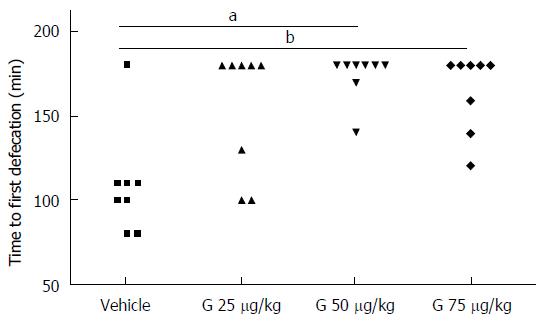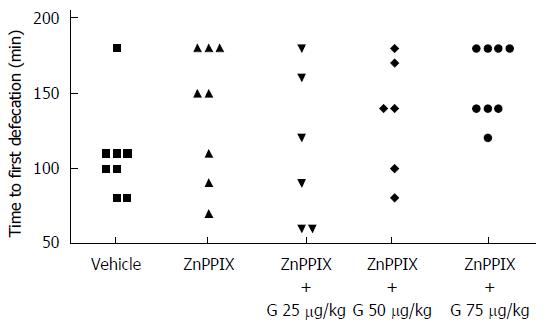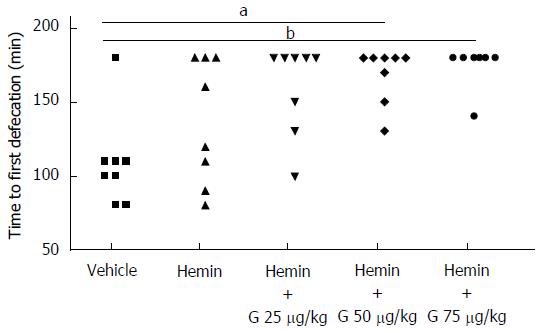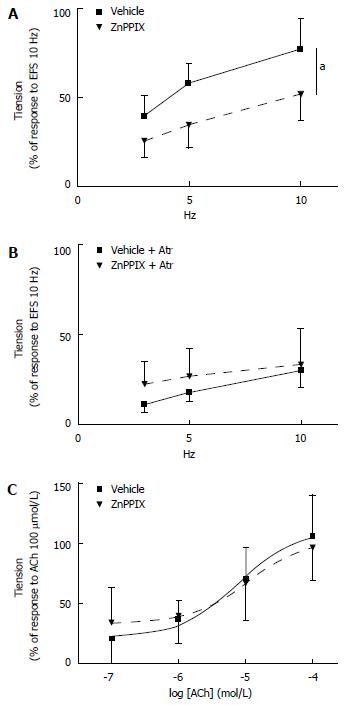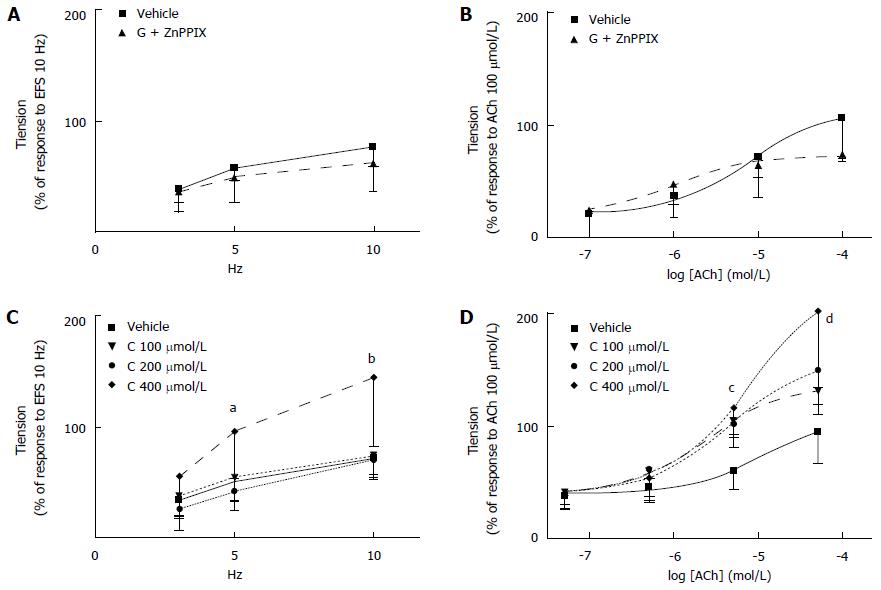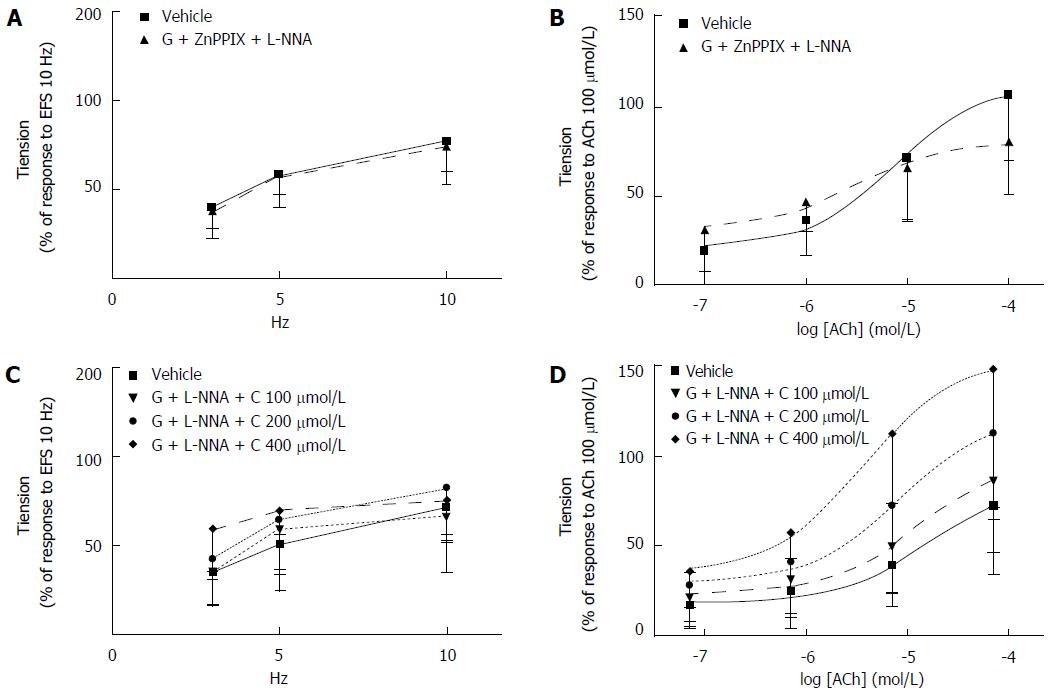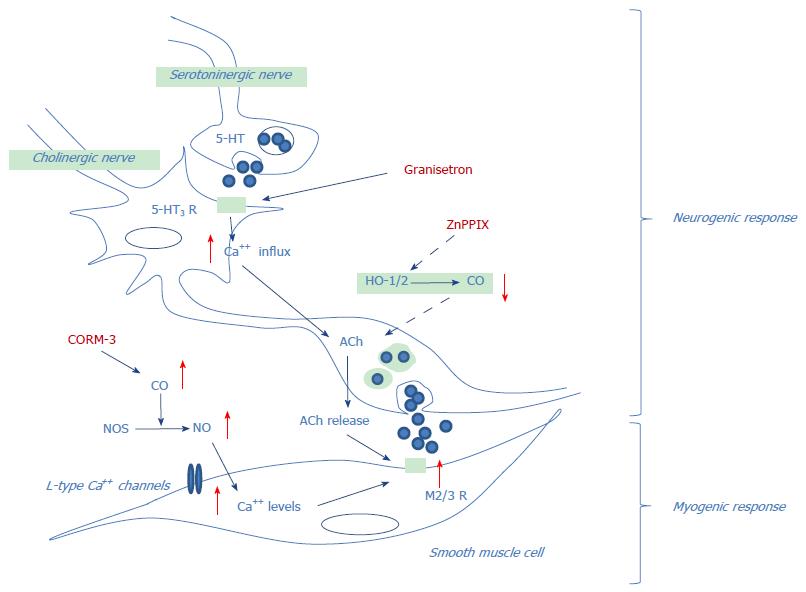Copyright
©The Author(s) 2016.
World J Gastroenterol. Nov 14, 2016; 22(42): 9333-9345
Published online Nov 14, 2016. doi: 10.3748/wjg.v22.i42.9333
Published online Nov 14, 2016. doi: 10.3748/wjg.v22.i42.9333
Figure 1 Effect of in vivo administration of granisetron on the time to first defecation.
In vivo treatment with granisetron (G) significantly increased the time to first defecation at doses of 50 and 75 μg/kg. Friedman’s test = 13 P = 0.005, post hoc: G 25 μg/kg vs vehicle, P = 0.132; G 50 μg/kg vs vehicle, aP = 0.045; G 75 μg/kg vs vehicle, bP = 0.045. Each point represents an individual observation.
Figure 2 Effect of in vivo administration of zinc protoporphyrin alone and with granisetron on the time to first defecation.
Zinc protoporphyrin (ZnPPIX) (50 μg/kg) did not affect the time to first defecation. Co-administration of ZnPPIX (50 μg/kg) with granisetron (G) (25, 50, 75 μg/kg) abolished the effect of G on its own. Friedman’s test = 10.486, P = 0.033; post-hoc comparisons: ZnPPIX vs vehicle: P = 1; G 25 μg/kg + ZnPPIX vs vehicle: P = 1; G 50 μg/kg + ZnPPIX vs vehicle: P = 1; G 75 μg/kg + ZnPPIX vs vehicle: P = 0.132. Each point represents an individual observation.
Figure 3 Effect of in vivo administration of hemin alone and with granisetron on the time to first defecation.
Hemin (50 μmol/L/kg) did not affect the time to first defecation. Co-administration of hemin (50 μmol/L/kg) with granisetron (G) (50, 75 μg/kg) resulted in an increased time to first defecation. Friedman’s test = 20.364 P = 0.000; post-hoc comparisons: hemin vs vehicle: P = 1; G 25 μg/kg + hemin vs vehicle: P = 0.108; G 50 μg/kg + hemin vs vehicle: aP = 0.028; G 75 μg/kg + hemin vs vehicle: bP = 0.004. Each point represents an individual observation.
Figure 4 Effects of in vitro treatment with granisetron on rat colon contractile response to electrical field stimulation and to acetylcholine.
A: Incubation with granisetron (G) (3 μmol/L, 15 min) did not significantly modify the electrical field stimulation (EFS)-induced contractile response compared to vehicle. ANOVA results: Ftreatments = 1.26, df = 1/9, P = 0.29; Ffrequencies = 22.50, df = 2/18, P = 0.001; Ftreatments x frequencies = 1.79, df = 2/18, P = 0.21; B: Incubation with G (3 μmol/L, 15 min) did not affect the contractile response to acetylcholine (ACh) (0.1-100 μmol/L) compared to vehicle. ANOVA results: Ftreatments = 3.48, df = 1/9, P = 0.09; Fconcentrations = 21.35, df = 3/27, P < 0.0001; Ftreatments x concentrations = 0.08, df = 3/27, P = 0.85. Values are expressed as the mean ± SD of 6-8 experiments.
Figure 5 Effects of in vitro treatment with zinc protoporphyrin on rat colon contractile response to electrical field stimulation, without and with atropine, and to acetylcholine.
A: Incubation with zinc protoporphyrin (ZnPPIX) (10 μmol/L, 60 min) significantly reduced the electrical field stimulation (EFS)-induced contractile response compared to vehicle. ANOVA results: Ftreatments = 8.78, df = 1/9, aP = 0.016; Ffrequencies = 50.33, df = 2/18, P < 0.0001; Ftreatments x frequencies = 1.79, df = 2/18, P = 0.21); B: Co-incubation with ZnPPIX (10 μmol/L, 60 min) with atropine (3 μmol/L, 20 min) abolished the effect of ZnPPIX alone. ANOVA results: Ftreatments = 1.44, df = 1/11, P = 0,25; Ffrequencies = 37.66, df = 2/22, P < 0.0001; Ftreatments x frequencies = 2.74, df = 2/22, P = 0.09; C: Incubation with ZnPPIX (10 μmol/L, 60 min) had no effect on contractile response to atropine (Atr) (0.1-100 μmol/L) compared to vehicle. ANOVA results: Ftreatments = 0.006, df = 1/9, P = 0.94; Fconcentrations = 36.89, df = 3/27, P < 0.0001; Ftreatments x concentrations = 0.84, df = 3/27, P = 0.45. Values are expressed as the mean ± SD of 6-8 experiments.
Figure 6 Effects of in vitro treatment with CORM-3 on rat colon contractile response to electrical field stimulation, without and with atropine, and to acetylcholine.
A: Incubation with CORM-3 (C) (400 μmol/L) significantly increased the electrical field stimulation (EFS)-induced contractile response compared to vehicle at 10 Hz. ANOVA results: Ftreatments = 2.75, df = 3/20, P = 0.07; Ffrequencies = 55.38, df = 2/40, P < 0.0001; Ftreatments x frequencies = 4.36, df = 6/40, P = 0.002. At 10 Hz: C (400 μmol/L) vs vehicle aP = 0.01; B: Co-incubation of C (100-400 μmol/L) with atropine (Atr) (3 μmol/L, 20 min) abolished the effect of C when administered alone. ANOVA results: Ftreatments = 3.06, df = 3/20, P = 0.052; Ffrequencies = 50.05, df = 2/40, P < 0.0001; Ftreatmentss x frequencies = 1.14, df = 6/40, P = 0.36; C: Incubation with C (400 μmol/L) increased the contractile response to acetylcholine (ACh) (100 μmol/L) compared to vehicle. ANOVA results: Ftreatments = 2.28, df = 3/22, P = 0.11; Fconcentrations = 86.22, df = 3/66, P < 0.0001; Ftreatments x concentrations = 3.49, df = 9/66, P = 0.02. For ACh 100 μmol/L: C (400 μmol/L) vs vehicle: bP = 0.012. Values are expressed as the mean ± SD of 6-8 experiments.
Figure 7 Effects of in vitro treatment with granisetron and zinc protoporphyrin and with granisetron and CORM-3 on rat colon contractile response to electrical field stimulation (EFS) and to acetylcholine (ACh).
A: Co-incubation with granisetron (G) (3 μmol/L, 15 min) and zinc protoporphyrin (ZnPPIX) (10 μmol/L, 60 min) did not significantly modify the EFS-induced contraction compared to vehicle. ANOVA results: Ftreatments = 0.43, df = 1/8, P = 0.53; Ffrequencies = 55.35, df = 2/16, P < 0.0001; Ftreatments x frequencies = 1.66, df = 2/16, P = 2; B: Co-incubation with G (3 μmol/L, 15 min) and ZnPPIX (10 μmol/L, 60 min) did not modify the myogenic contractile response to acetylcholine (ACh) (0.1-100 μmol/L) compared to vehicle. ANOVA results: Ftreatments = 0.22, df = 1/8, P = 0.65; Fconcentrations = 39.19, df = 3/24, P < 0.0001; Ftreatments x concentrations = 4.06, df = 3/24, P = 0.02; C: Co-incubation with G (3 μmol/L, 15 min) and CORM-3 (C) (400 μmol/L) increased the contractile response to EFS at 5 and 10 Hz compared to vehicle. ANOVA results: Ftreatments = 5.47, df = 3/19, P < 0.01; Ffrequencies = 55.40, df = 2/38, P < 0.0001; Ftreatments x frequencies = 3.05, df = 6/38, P = 0.04. G (3 μmol/L, 15 min) and C (400 μmol/L) vs vehicle at 5 Hz: aP = 0.007 and at 10 Hz: bP = 0.001; D: Co-incubation of G (3 μmol/L, 15 min) and C (400 μmol/L) increased the contractile response at ACh 10 and 100 μmol/L compared to vehicle. ANOVA results: Ftreatments = 7.40, df = 3/19, P = 0.002; Fconcentrations = 61.69, df = 3/57, P < 0.0001; Ftreatments x concentrations = 3.55, df = 9/57, P = 0.027. G (3 μmol/L, 15 min) and C (400 μmol/L) compared to vehicle at ACh 10 μmol/L: cP = 0.001 and at ACh 100 μmol/L: dP = 0.001. Values are expressed as the mean ± SD of 6-8 experiments.
Figure 8 Effects of in vitro treatment with granisetron, zinc protoporphyrin and NG-nitro-L-Arginine and with granisetron, CORM-3 and L-NNA on rat colon contractile response to electrical field stimulation and to acetylcholine.
A: Co-incubation with granisetron (G) (3 μmol/L, 15 min), ZnPPIX (10 μmol/L, 60 min) and NG-nitro-L-Arginine (L-NNA) (100 μmol/L, 20 min) did not affect the electrical field stimulation (EFS)-induced contractile response compared to vehicle. ANOVA results: Ftreatments = 0.08, df = 1/9, P = 0.79; Ffrequencies = 24.89, df = 2/18, P < 0.0001; Ftreatments x frequencies = 0.03, df = 2/18, P = 0.91; B: Co-incubation with G (3 μmol/L, 15 min), zinc protoporphyrin (ZnPPIX) (10 μmol/L, 60 min) and L-NNA (100 μmol/L, 20 min) did not affect the contractile response to acetylcholine (ACh) (0.1-100 μmol/L) compared to vehicle. ANOVA results: Ftreatments = 0.03, df = 1/9, P = 0.87; Fconcentrations = 45.18, df = 3/27, P < 0.0001; Ftreatments x concentrations = 3.90, df = 3/27, P = 0.04; C: Co-incubation with G (3 μmol/L, 15 min), C (100-400 μmol/L) and L-NNA (100 μmol/L, 20 min) did not affect the EFS-induced contractile response compared to vehicle. ANOVA results: Ftreatments = 0.83, df = 3/18, P = 0.49, Ffrequencies = 25.51, df = 2/36, P < 0.0001; Ftreatments x frequencies = 0.89, df = 6/36, P = 0.50; D: Co-incubation with G (3 μmol/L, 15 min), CORM-3 (C) (100-400 μmol/L) and L-NNA (100 μmol/L, 20 min) did not affect the contractile response to ACh (0.1-100 μmol/L) compared to vehicle. ANOVA results: Ftreatments = 3.38, df = 3/17, P = 0.04, Fconcentrations = 33.08, df = 3/57, P < 0.0001; Ftreatments x concentrations = 1.47, df = 9/51, P = 0.25. Values are expressed as the mean ± SD of 6-8 experiments.
Figure 9 Effects of in vitro treatment with granisetron and NG-nitro-L-Arginine on rat colon contractile response to electrical field stimulation and to acetylcholine.
A: Co-incubation with granisetron (G) (3 μmol/L, 15 min) and NG-nitro-L-Arginine (L-NNA) (100 μmol/L, 20 min) resulted in significantly increase of electrical field stimulation (EFS)-induced contractile responses at all frequencies used compared to vehicle. ANOVA results: Ftreatments = 6.73, df = 1/11, aP = 0.025; Ffrequencies = 16.80, df = 2/22, P = 0.001; Ftreatments x frequencies = 1.26, df = 2/22, P = 0.30; B: Co-incubation with G (3 μmol/L, 15 min) and L-NNA (100 μmol/L, 20 min) resulted in significantly increased contractile response induced by acetylcholine (ACh) (10 and 100 μmol/L) compared to vehicle. ANOVA results: Ftreatments = 25.33, df = 1/11, P < 0.001; Fconcentrations = 80.22, df = 3/33, P < 0.0001; Ftreatments x concentrations = 15.8, df = 3/33, P = 0.001. T-test for ACh 10 μmol/L: t = 5.06, bP = 0.000 and for ACh 100 μmol/L: t = 4.99, cP = 0.000. Values are expressed as the mean ± SD of 6-8 experiments.
Figure 10 Potential relationship between granisetron, ZnPPIX (HO-1/2 inhibitor), and CORM-3 (CO-releasing agent) on colon neurogenic and myogenic contractile responses.
Acting on 5-HT3 receptors, granisetron may increase calcium influx, thus facilitating the release of acetylcholine (ACh) (neurogenic response), which in turn elicits a myogenic contractile response. By inhibiting the heme oxygenase (HO)-mediated carbon monoxide (CO) production, ZnPPIX may reduce the nerve terminal release of ACh, thereby counteracting granisetron effects. By releasing carbon monoxide (CO), CORM-3 may enhance the ACh-mediated myogenic contraction via a nitric oxide (NO)-dependent mechanism resulting in increased intracellular cAMP and calcium levels, with subsequent activation of L-type calcium channels and potentiation of the granisetron-mediated myogenic response.
- Citation: Nacci C, Fanelli M, Potenza MA, Leo V, Montagnani M, De Salvia MA. Carbon monoxide contributes to the constipating effects of granisetron in rat colon. World J Gastroenterol 2016; 22(42): 9333-9345
- URL: https://www.wjgnet.com/1007-9327/full/v22/i42/9333.htm
- DOI: https://dx.doi.org/10.3748/wjg.v22.i42.9333









